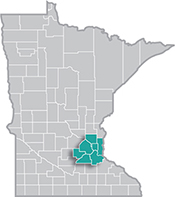 The Minneapolis-St. Paul metropolitan area is a national leader in finance, advanced manufacturing, agriculture and retailing.
The Minneapolis-St. Paul metropolitan area is a national leader in finance, advanced manufacturing, agriculture and retailing.
Medical devices, electronics and processed foods are strong suits recognized globally.
Want the freshest data delivered by email? Subscribe to our regional newsletters.
7/1/2015 2:23:55 PM
Tim O'Neill
Recently, CNBC named Minnesota as the nation's top state for business. This ranking was based off of 60 measures of competitiveness, separated by 10 categories including:
| Category | Minnesota's Rank |
|---|---|
| Education | 2 |
| Quality of life | 3 |
| Economy | 5 |
| Technology and innovation | 6 |
| Infrastructure | 9 |
| Workforce | 13 |
| Business friendliness | 23 |
| Access to capital | 23 |
| Cost of living | 32 |
| Cost of doing business | 35 |
In addition to CNBC's annual study, the Department of Employment and Economic Development (DEED) also collects comparative data for the state of Minnesota, as well as the Twin Cities metropolitan area. The Compare Twin Cities data tool, for example, shows how the Twin Cities metro stacks up with other major metropolitan areas in business climate, workforce participation, industry employment, educational attainment, economic performance, innovation, energy, taxes, and quality of life. This blog will briefly highlight the Twin Cities' achievements in education, economy, and workforce.
The Twin Cities metropolitan area bolsters Minnesota's overall rankings within CNBC's categories. 33.5 percent of Minnesotans have a bachelor's degree or higher; nearly two in five residents have this educational attainment within the Twin Cities, which accounts for 64 percent of the state's total population. A study done by Central Connecticut State University shows that, as of 2013, the Twin Cities region ranks third out of the 30 largest metropolitan areas in the nation for literacy.
As for the economy, the Twin Cities region has added over 100,000 jobs since 2010, growing slightly faster than the state as a whole. At 3.4 percent, the region also has a lower unemployment rate than the state, which itself is the 5th lowest in the nation. It should also be noted that the region ranks first among the 30 largest metropolitan areas in the number of Fortune 500 companies per capita, and fifth overall.
The CNBC study placed the highest importance with workforce, or the quality and availability of Minnesota's workers. It is of special note that the Twin Cities region has the highest labor force participation rate among the nation's largest metropolitan areas, at 71.9 percent.
It's great news for Minnesota to be the nation's top state for business. With a strong, diverse economy, low unemployment, and a highly skilled and educated workforce, the Twin Cities region only strengthens Minnesota's business climate. Along with DEED's comparative tools, check out the following links to see where Minnesota and the Twin Cities rank highly:
Contact Tim O'Neill at 651-259-7401.